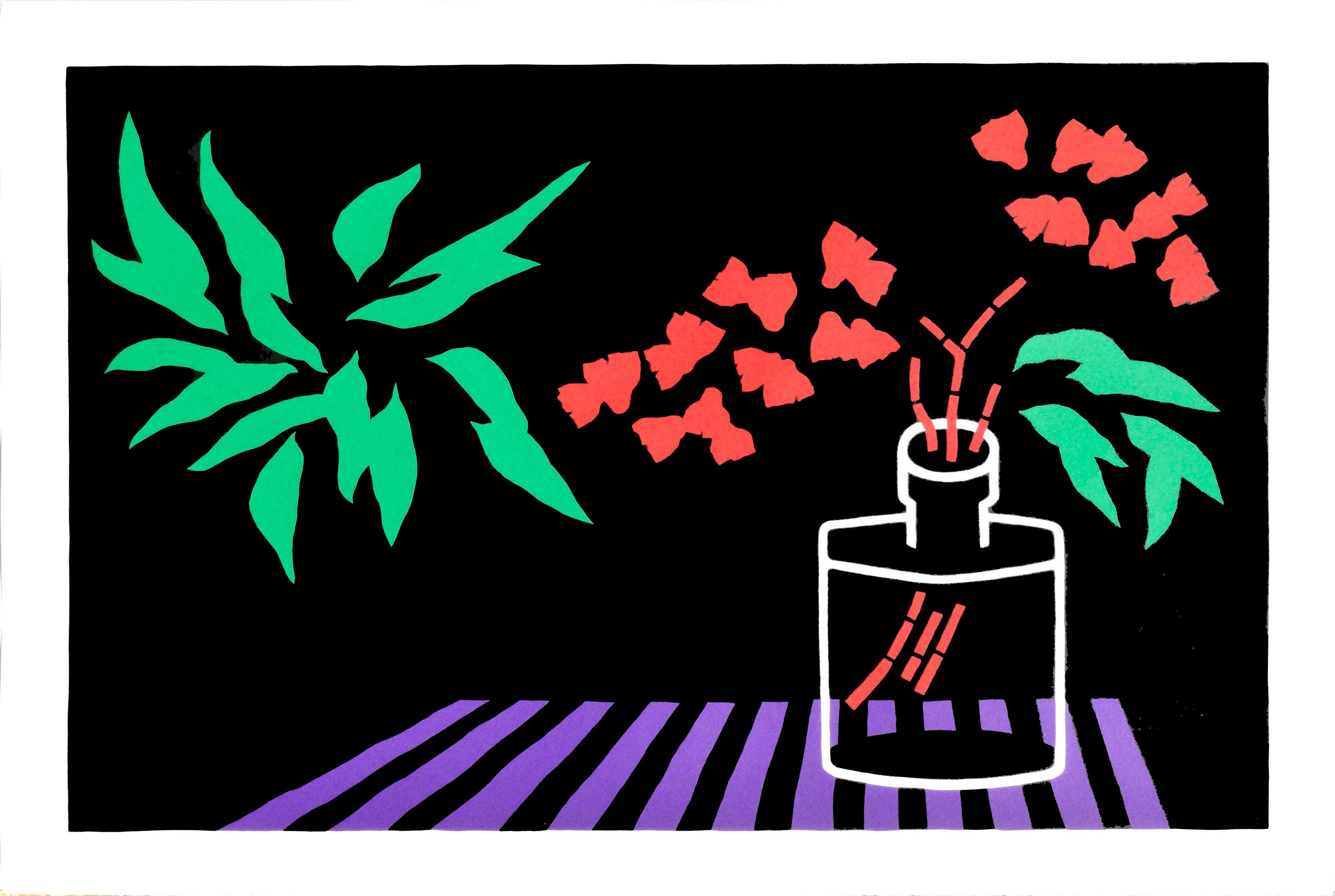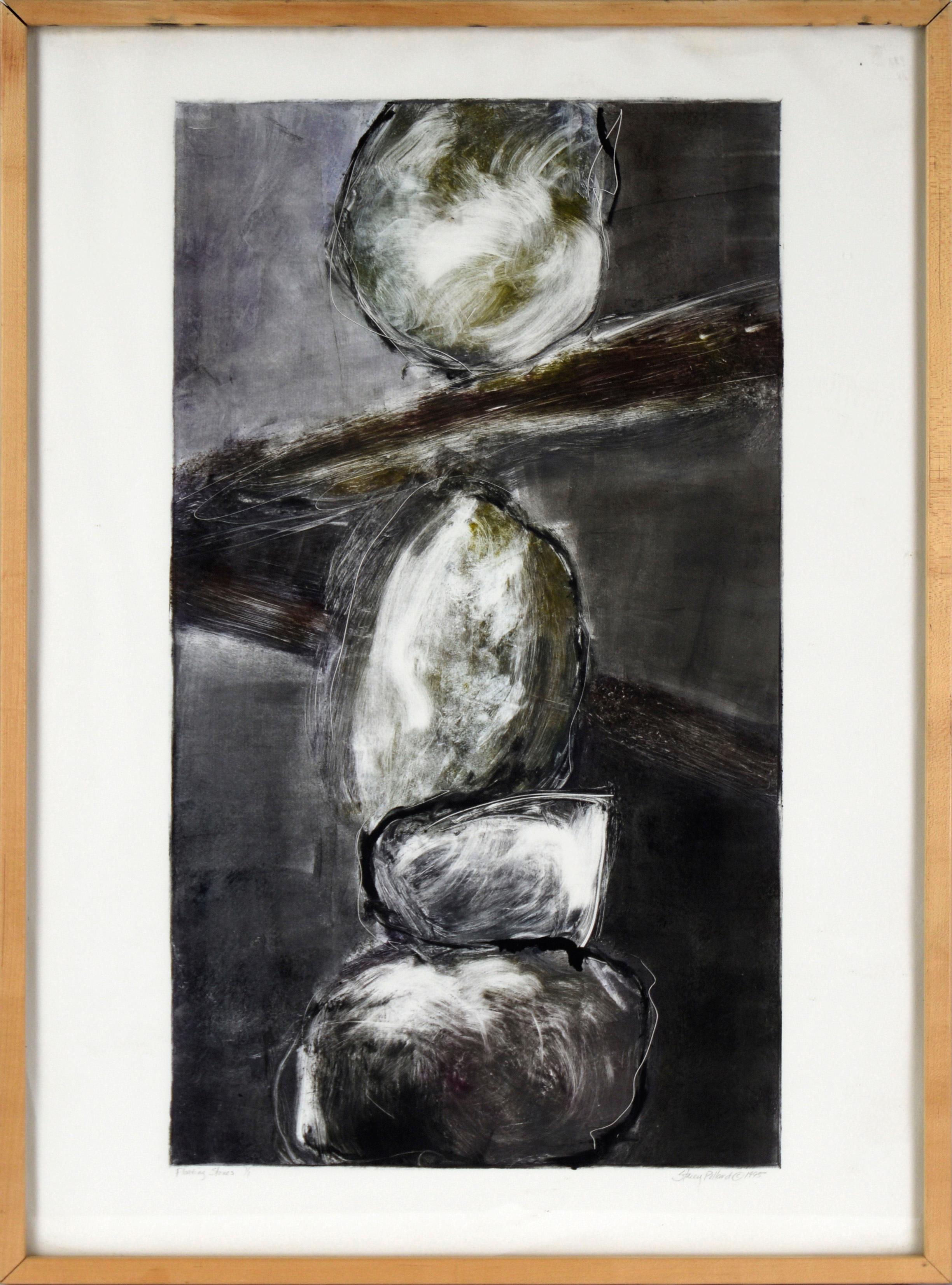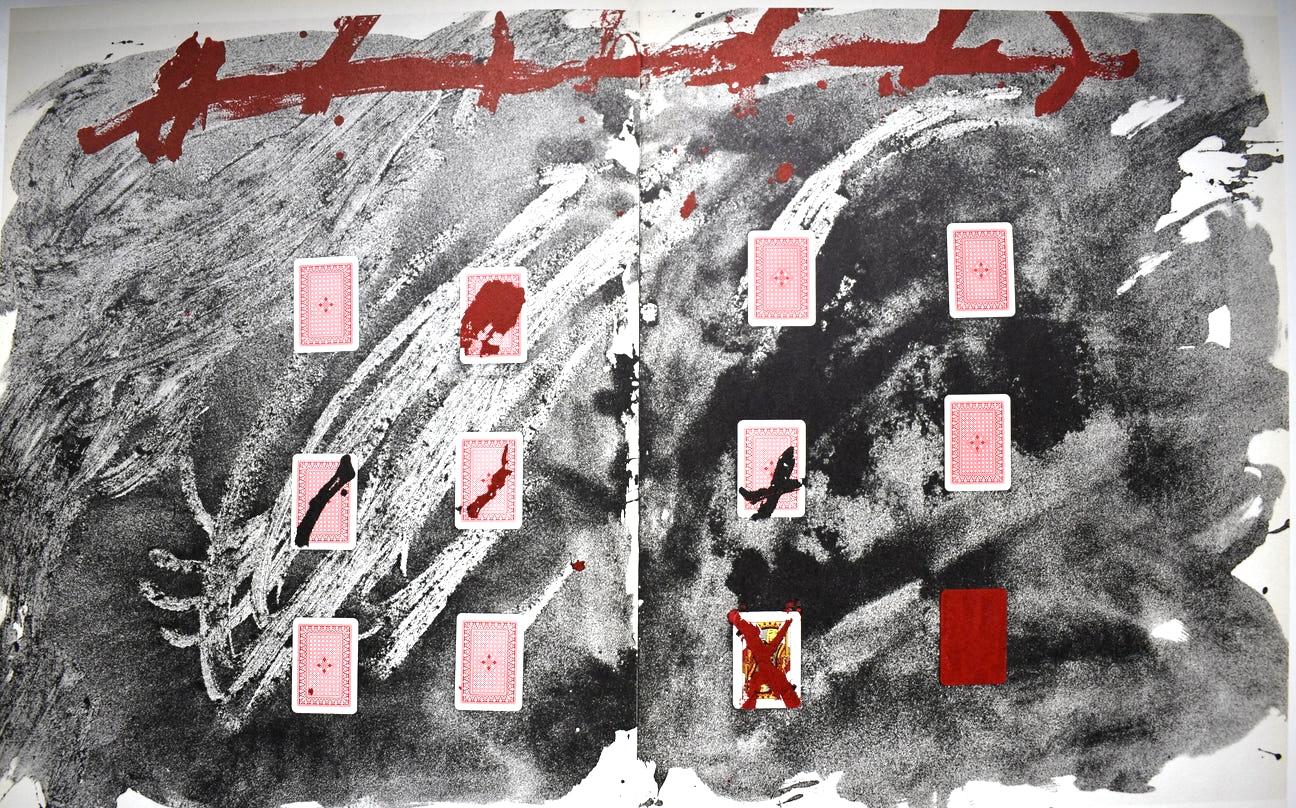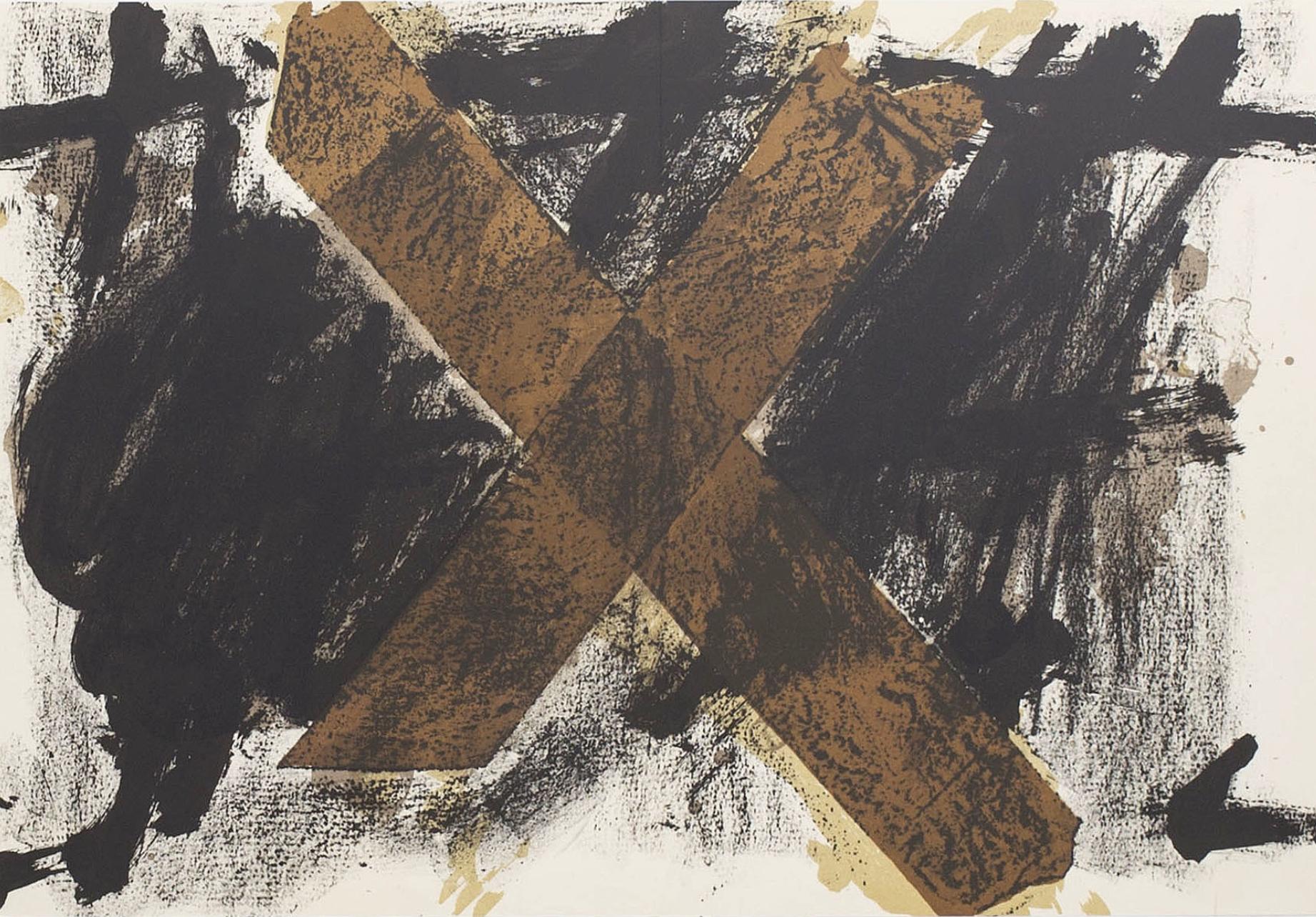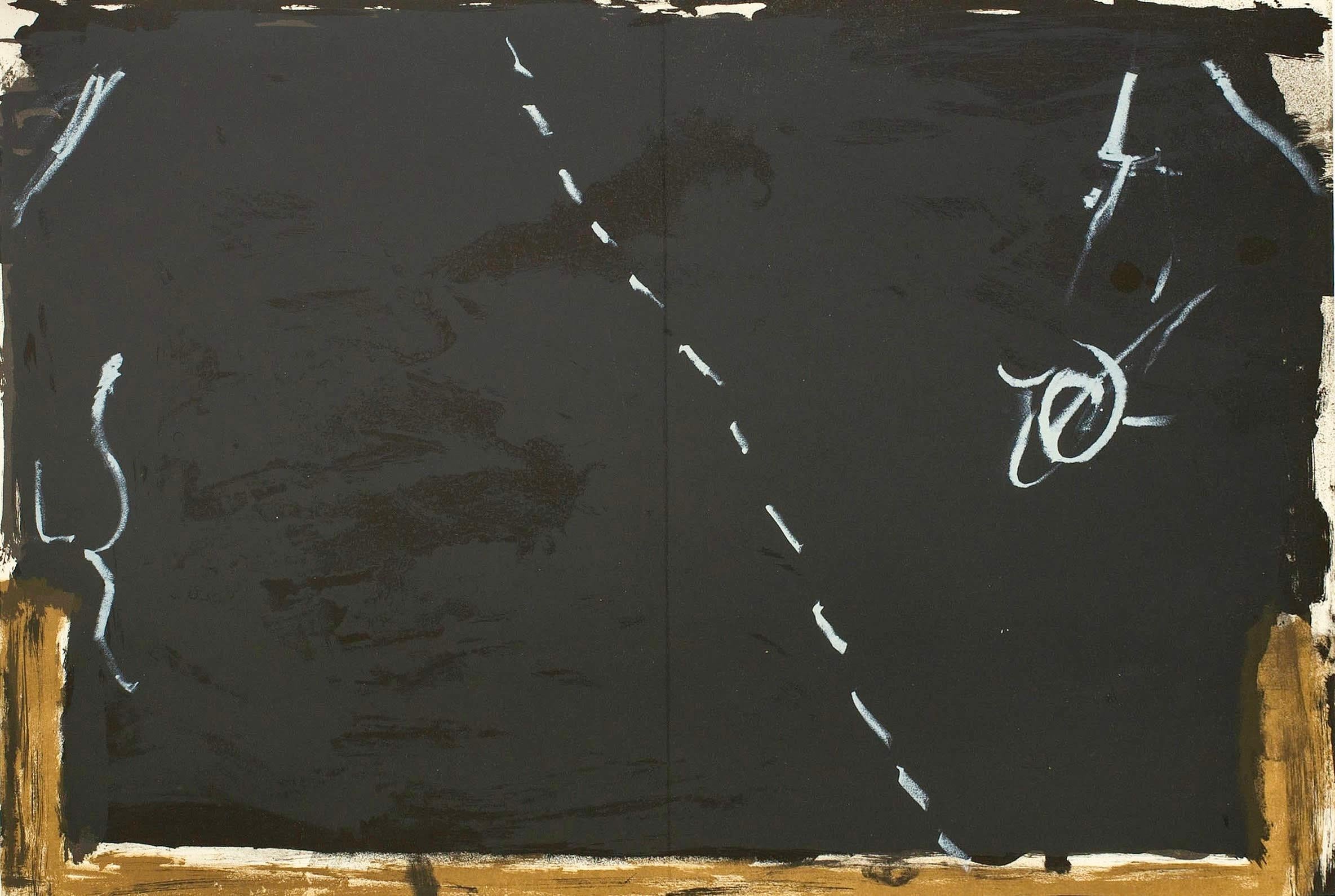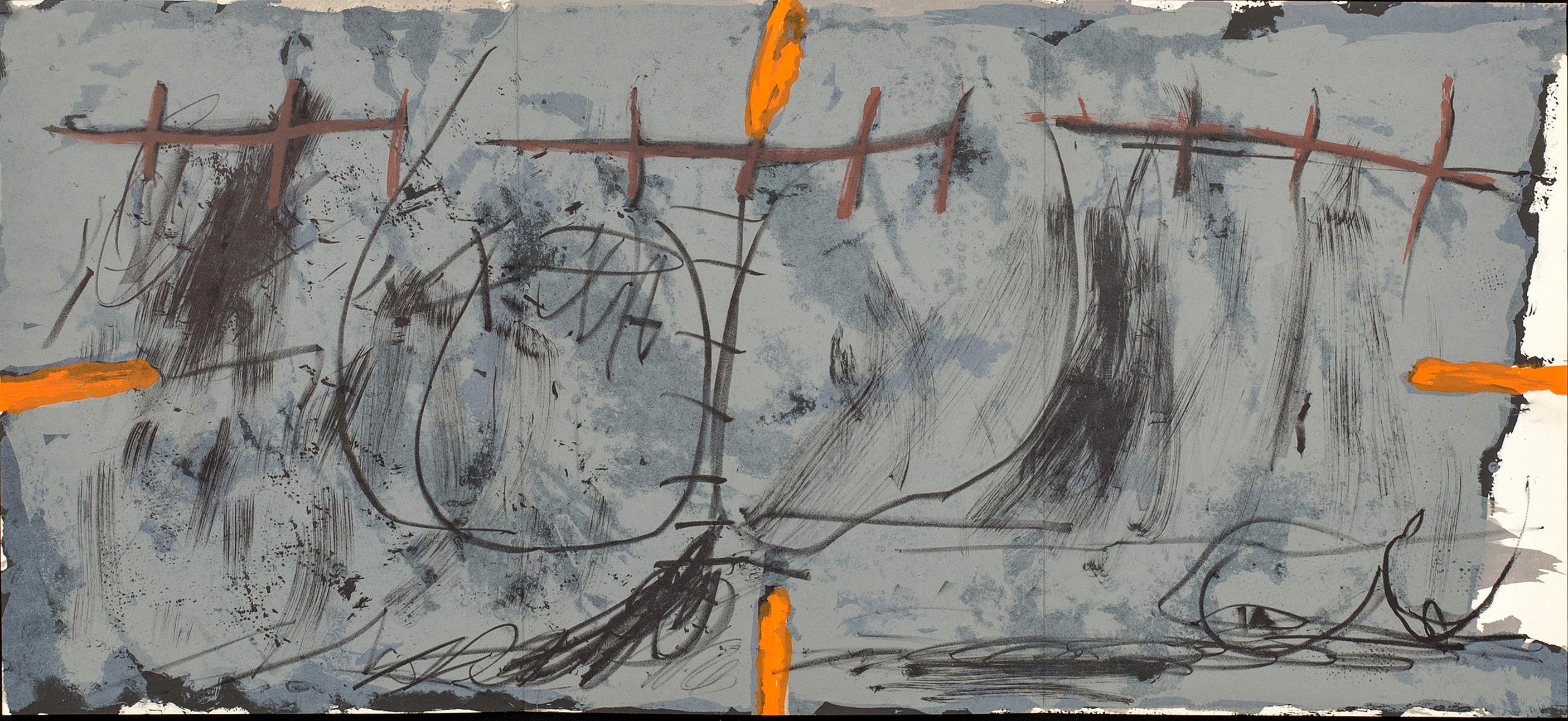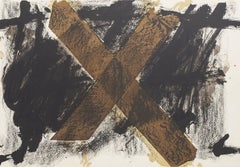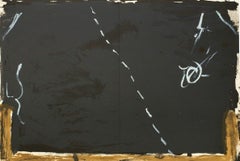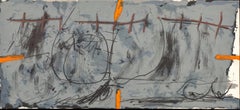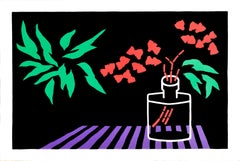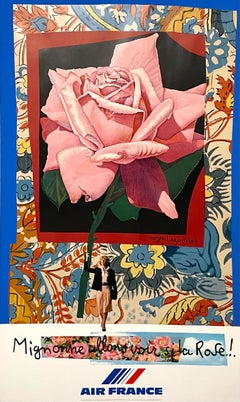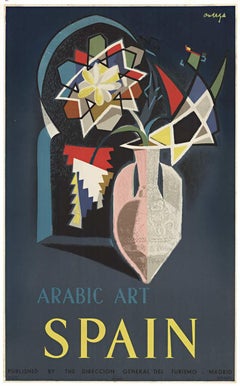Items Similar to Tàpies, Composition, Derrière le miroir (after)
Want more images or videos?
Request additional images or videos from the seller
1 of 9
Tàpies, Composition, Derrière le miroir (after)1974
1974
About the Item
Lithograph on vélin paper. Inscription: Unsigned and unnumbered, as issued. Good condition, with centerfold, as issued. Notes: From Derrière le miroir, N° 210, 1974. Published by Aimé Maeght, Éditeur, Paris; printed by Éditions Pierre à Feu, Galerie Maeght, Paris. Excerpted from the volume (translated from French), The illustrations, pages 2-7, 10 and 15 of this issue of Derrière le Miroir are original lithographs of Tapies, drawn in the workshops of l'imprimerie Arte, Adrien Maeght. The other illustrations are reproductions of monotypes drawn by the painter. The vélin d'Arches luxury edition is limited to 150 examples numbered and signed by the artist. Excerpted from a Christie’s, New York lot essay, The life span of Derrière le Miroir was thirty-five years. Publication began in 1946. Aimé Maeght, initiator of Derrière le Miroir, had already made few attempts to start publications illustrated with fine printed lithographs in colours in the years prior to the launch of Derrière le Miroir. The name, Derrière le Miroir was suggested by Jacques Kober, manager of Galerie Maeght. The gallery had opened in 1945; the first number of Derrière le Miroir was released a year later. For this first issue Geer van Velde was invited to create lithographs to illustrate the publication. The lithographs in the first issue was printed by Mourlot, Paris. The first three issues of Derrière le Miroir were unsuccessful for Maeght as far as the edition size—the initial print-runs were far too large. From 30,000 for the first issue, the number was taken down to 10,000 for numbers two and three, until Derrière le Miroir number four was published in an edition of 1500. Maeght instituted a policy whereby unsold issues were recycled and used for the fabrication of new paper for the coming editions—this served to both conserve resources and also usually result in ultimate edition sizes far less than 1,500. With number four, the permanent format for Derrière le Miroir was established. Lithographs in colours were key; text was limited to comments on the featuring artist's exhibition taking place in the Galerie Maeght, and this catalogue format was defining to Derrière le Miroir. Galerie Maeght took on the leading role in Paris and presented all main artists including Braque, Matisse, Chagall, Léger, Bonnard, Chillida and many more. So too did Derrière le Miroir. The idea of a magazine was meanwhile still on the mind of Aimé Maeght. He found an insert as a solution. Two, and later four, pages of art review were inserted from 1952 onwards. In 1968 this find had ripened to independency and the dream of Aimé Maeght was now a tangible fact named l'Art vivant. Derrière le Miroir was on it's own again. Over 250 issues in a row. At that point publisher Aimé Maeght wished to make a mark with the publication of an hommage to all who once contributed to the magazine which came in the form of issue number 250, but was delayed by the death of Aimé Maeght. It was published after number 253 in 1982 and became a tribute to Aimé and Marguérite Maeght and 35 years of friendship with artists and poets. The era of Derrière le Miroir was closed with that final publication.
ANTONI TAPIES (1923-2012) was a Spainish painter, sculptor and art theorist. Tàpies was first introduced to Modern Art as he entered secondary school in 1934. He saw a famous Christmas issue of the magazine, D’ací i d’allà, which contained reproductions of works by artists such as Marcel Duchamp, Georges Braque, Wassily Kandinsky and Pablo Picasso. At 17, Tàpies suffered a near-fatal heart attack caused by tuberculosis. He spent two years as a convalescent in the mountains, reading widely and pursuing an interest in art that had already expressed itself when he was in his early teens.
- Creation Year:1974
- Dimensions:Height: 15 in (38.1 cm)Width: 22 in (55.88 cm)
- Medium:
- Movement & Style:
- After:Antoni Tàpies (1923 - 2012, Spanish)
- Period:
- Condition:
- Gallery Location:Auburn Hills, MI
- Reference Number:1stDibs: LU1465214018412
About the Seller
4.9
Gold Seller
Premium sellers maintaining a 4.3+ rating and 24-hour response times
Established in 1978
1stDibs seller since 2021
1,064 sales on 1stDibs
Typical response time: <1 hour
- ShippingRetrieving quote...Shipping from: Auburn Hills, MI
- Return Policy
Authenticity Guarantee
In the unlikely event there’s an issue with an item’s authenticity, contact us within 1 year for a full refund. DetailsMoney-Back Guarantee
If your item is not as described, is damaged in transit, or does not arrive, contact us within 7 days for a full refund. Details24-Hour Cancellation
You have a 24-hour grace period in which to reconsider your purchase, with no questions asked.Vetted Professional Sellers
Our world-class sellers must adhere to strict standards for service and quality, maintaining the integrity of our listings.Price-Match Guarantee
If you find that a seller listed the same item for a lower price elsewhere, we’ll match it.Trusted Global Delivery
Our best-in-class carrier network provides specialized shipping options worldwide, including custom delivery.More From This Seller
View AllTàpies, Composition, Derrière le miroir (after)
By Antoni Tàpies
Located in Auburn Hills, MI
Lithograph on vélin paper. Inscription: Unsigned and unnumbered, as issued. Good condition, with centerfold, as issued. Notes: From Derrière le miroir, N° 207, 1974. Published by Aim...
Category
1970s Post-War Still-life Prints
Materials
Lithograph
Tàpies, Composition (Galfetti 315), Derrière le miroir (after)
By Antoni Tàpies
Located in Auburn Hills, MI
Lithograph on vélin paper. Inscription: Unsigned and unnumbered, as issued. Good condition, with centerfold, as issued. Notes: From Derrière le miroir, N° 200, 1972. Published by Aim...
Category
1970s Post-War Still-life Prints
Materials
Lithograph
$716 Sale Price
44% Off
Free Shipping
Tàpies, Composition (Galfetti 83-86), Derrière le miroir (after)
By Antoni Tàpies
Located in Auburn Hills, MI
Lithograph on vélin paper. Inscription: Unsigned and unnumbered, as issued. Good condition, with centerfold, as issued. Notes: From Derrière le miroir, N° 168, 1967. Published by Aim...
Category
1960s Post-War Still-life Prints
Materials
Lithograph
$716 Sale Price
44% Off
Free Shipping
Tàpies, Composition (Galfetti 83-86), Derrière le miroir (after)
By Antoni Tàpies
Located in Auburn Hills, MI
Lithograph on vélin paper. Inscription: Unsigned and unnumbered, as issued. Good condition, with centerfold, as issued. Notes: From Derrière le miroir, N° 168, 1967. Published by Aim...
Category
1960s Post-War Still-life Prints
Materials
Lithograph
$1,356 Sale Price
20% Off
Free Shipping
Tàpies, Composition, Derrière le miroir (after)
By Antoni Tàpies
Located in Auburn Hills, MI
Lithograph on vélin paper. Inscription: Unsigned and unnumbered, as issued. Good condition, with centerfold, as issued. Notes: From Derrière le miroir, N° 210, 1974. Published by Aim...
Category
1970s Post-War Still-life Prints
Materials
Lithograph
Tàpies, Composition (Galfetti 83-86), Derrière le miroir (after)
By Antoni Tàpies
Located in Auburn Hills, MI
Lithograph on vélin paper. Inscription: Unsigned and unnumbered, as issued. Good condition, with centerfold, as issued. Notes: From Derrière le miroir, N° 168, 1967. Published by Aim...
Category
1960s Post-War Still-life Prints
Materials
Lithograph
$716 Sale Price
44% Off
Free Shipping
You May Also Like
Botanical Still-Life with House Plants & Red Roses
By Sidney Jonas Budnick
Located in Soquel, CA
Botanical Still-Life with House Plants & Red Roses
Dramatic abstracted botanical still life of house plants and red roses Lithograph by Sidney Jonas Budnick (American, 1921-1994), 19...
Category
1970s Post-War Abstract Prints
Materials
Ink, Laid Paper, Lithograph
"Floating Stones" Monoprint in Ink on Heavy Paper
Located in Soquel, CA
"Floating Stones" Monoprint in Ink on Heavy Paper
High-contrast composition by California artist Stacey Pollard (American, b. 1962). Although primarily abstract in nature, there are...
Category
Early 2000s Post-War Abstract Prints
Materials
Ink, Laid Paper, Lithograph
$1,000 Sale Price
20% Off
French Modernist Mourlot Lithograph Vintage Air France Poster Roger Bezombes
By Roger Bezombes
Located in Surfside, FL
Vintage French Travel Poster, Air france
Roger Bezombes
(1913-1994) French
Bezombes was a painter, sculptor, medalist, and designer. He studied in Paris, at the École des Beaux-Arts, and was much influenced by his friendship with Maurice Denis. Heavily influenced by surrealism, He worked principally as a painter, adopting the saturated Fauvist colors of Henri Matisse in landscapes and figure studies often based on observation of “exotic” cultures, notably Mediterranean and North African. Constrained, because a very young orphan, to all kinds of professions which provide him with the material means to devote himself to painting - he participated in 1930 in the installation of the exhibition of the Bauhaus at the Grand Palais-, Roger Bezombes is student of the National School of Fine Arts in Paris. (Ecole des Beaux Artes) He was trained in the art of fresco by Paul Baudoüin, René Barotte nonetheless restores that the young man's preference goes to the practice of "truancy" which he uses to make copies at the Louvre Museum. It’s the time when Paul Gauguin’s paintings, Vincent Van Gogh and Henri Matisse are revealed to him by Maurice Denis with whom he will remain close until his accidental death, painting him on his funeral bed on November 14, 1943. He executed surrealist tapestry designs for Aubusson and Gobelin tapestries, posters (winning the Grand Prix de l'Affiche Francaise in 1984), costumes and sets for ballets at the Metropolitan Opera House in New York, reliefs and murals. In 1965 he took up medal-making, expressing in his numerous metallic works for the Paris Mint that obsession with found objects which is also evident in his large-scale sculpture and in his posters.
He designed posters for Air France and for the French national railways.
Roger Bezombes went to Africa for the first time in 1936 thanks to a travel grant and received the same year the second grand prize of Rome . In 1937 he traveled around Morocco where he became friends with Albert Camus. The year 1938 offered him both his first solo exhibition at the Charpentier gallery in Paris with paintings and gouaches on the theme of Morocco and the attribution of the national grand prize for the arts, earning him a great journey which , from Dakar to Algiers , takes it through Chad , Tamanrasset and Hoggar.
Roger Bezombes became a professor at the Julian Academy in 1950. For him, 1951 was the year of a trip to Greece and the year where he began his relationship with tapestry work.
Roger Bezombes visited Israel in 1953, Tunisia and Egypt in 1954. He was appointed official painter of the Navy in 1955. Pierre Mazars analyzes that “after a period where we notice the influence of Van Gogh and GeorgesBraque, particularly in his landscapes of Provence, he came to a more schematic writing, the colored spots and the thicknesses of material taking more of importance as the subject. He even performed composite works, half-watercolors, half-pasted papers, in which he incorporated pieces of newspapers”. He was elected titular to the Academy of Overseas Sciences in 1978. "The range of Bezombes' talent forms is remarkable,” writes Lynne Thornton, “ranging from paintings, murals, travel posters, tapestry cartons, book illustrations, monumental ceramic decorations, ballet and theater sets, totem sculptures, sculpture objects, jewelry and medallions”. He was part of the mid century mod School of Paris that included Leon Zack, Bernard Lorjou, Paul Augustin Aizpiri, Gabriel Godard, Michel Henry, Hans Erni, Bengt Lindstrom, Alfred Manessier, Andre Hambourg, Raymond Legueult and Jean Rigaud.
Select Solo Exhibitions:
1938: Galerie Charpentier, Paris
1950, '53, '55, '57: Galerie Andre Weil, Paris
1953:Wildenstein Gallery, London
1954: Institut Francais, Cologne
1956: Galerie Matarasso, Nice
1957: Horn Gallery, Luxembourg; Guilde de la Gravure, Paris
1958: Denys-Puech Museum, Rodez
1962: Musee de l'Athenee, Geneva;
Chateau Grimaldi, Cagnes-sur-Mer
1966: Galerie des Ponchettes, Nice
1967: Galerie Martel, Montreal
1968: Romanet-Vercel Gallery, New York;
Reattu Museum, Arles; Le Corbusier Center, Firminy
1969: Galerie Philippe...
Category
1980s Modern Abstract Prints
Materials
Lithograph
Original Arabic Art - Spain vintage travel poster
By José Ortega
Located in Spokane, WA
Original Arabic Art – Spain vintage travel poster. Artist: Jose Ortega. Size: 24.5" x 39.5". C. 1950. Original vintage European travel poster...
Category
1950s Abstract Geometric Still-life Prints
Materials
Lithograph
$620 Sale Price
20% Off
HALLELUJAH TO PEACE Signed Lithograph, Stone Tablet, Abstract Ancient Writing
By Moshe Castel
Located in Union City, NJ
HALLELUJAH TO PEACE by the Israeli artist Moshe Castel (1909-1991) is a limited edition lithograph printed in 12 colors using traditional hand lithography techniques on archival Somerset paper 100% acid free. In HALLELUJAH TO PEACE, a three dimensional relief 3D effect is visible in the black writings and textural stone tablet achieved by using shades of dark blue gray and black with a bold cool red background accenting the stone tablet sacred writings. Castel creates a very aesthetically appealing and captivating contemporary interpretation of ancient Jewish symbolism.
Print size - 21.75 x 29.5 inches, unframed, excellent condition, pencil signed by Moshe Castel
Edition size - 150, plus proofs
Year published - 1980
Printer - J K Fine Art Editions Co., NY
Moshe Elazar Castel born in Jerusalem, Ottoman Palestine, in 1909, to Rabbi Yehuda Castel and his wife Rachel. The family was descended from Spanish Jews from Castile who immigrated to the Holy Land after the expulsion of the Jews from Spain in 1492. Castel attended his father’s school until the age of 13. He went on to study at the Bezalel Art School in Jerusalem, where he was encouraged by his teacher to study in Paris furthering his art education at the Academie Julian and Ecole de Louvre in Paris. He was greatly influenced by European masters Rembrandt, Velasquez, Delacroix and Courbert after spending his days copying their works hanging in the Louvre. Castel returned to Palestine at the onset of WWII. The subject of Castel’s early paintings were scenes of Sephardic Jews in the Holy Land. In 1947, Castel helped to found the "New Horizons" (Ofakim Hadashim) group together with Yosef Zaritsky, Yehezkel Streichman...
Category
1980s Contemporary Still-life Prints
Materials
Lithograph
SCROLLS Signed Lithograph, Jewish History, Dead Sea Scrolls, Red, Gold, Black
By Moshe Castel
Located in Union City, NJ
SCROLLS by the Israeli artist Moshe Castel (1909-1991) is a limited edition lithograph printed using traditional hand lithography techniques on archival Somerset paper 100% acid free. SCROLLS is a dramatic abstract collage, its vertical arrangement depicting a grouping of yellow and gold beige papyrus scroll fragments against a textured background of rich vibrant red and black. Ancient alphabet symbols written on the parchment are visible resembling Aramaic letters which create a mystical quality evoking the biblical history of the Dead Sea Scrolls. Aramaic was once the main language of the Jews and appears in some of the Dead Sea Scrolls. It is closely related to Hebrew with the script being very similar.
In SCROLLS, Moshe Castel creates a very aesthetically appealing and captivating contemporary arrangement of ancient Jewish symbolism.
Print size - 29.75 x 21.5 in. unframed, excellent condition, vivid colors, hand signed in pencil by Moshe Castel
Edition size - 150, plus proofs
Year published - 1981
Printer - J K Fine Art Editions Co., NY
Moshe Elazar Castel born in Jerusalem, Ottoman Palestine, in 1909, to Rabbi Yehuda Castel and his wife Rachel. The family was descended from Spanish Jews from Castile who immigrated to the Holy Land after the expulsion of the Jews from Spain in 1492. Castel attended his father’s school until the age of 13. He went on to study at the Bezalel Art School in Jerusalem, where he was encouraged by his teacher to study in Paris furthering his art education at the Academie Julian and Ecole de Louvre in Paris. He was greatly influenced by European masters Rembrandt, Velasquez, Delacroix and Courbert after spending his days copying their works hanging in the Louvre. Castel returned to Palestine at the onset of WWII. The subject of Castel’s early paintings were scenes of Sephardic Jews in the Holy Land. In 1947, Castel helped to found the "New Horizons" (Ofakim Hadashim) group together with Yosef Zaritsky, Yehezkel Streichman...
Category
1980s Contemporary Abstract Prints
Materials
Lithograph
